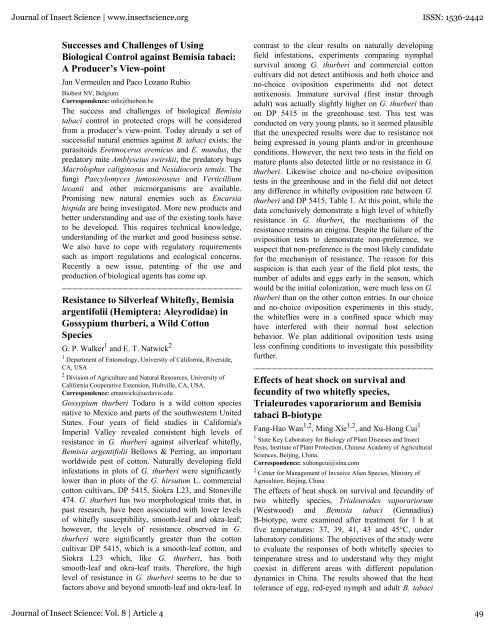Fourth International Bemisia Workshop International Whitefly ...
Fourth International Bemisia Workshop International Whitefly ...
Fourth International Bemisia Workshop International Whitefly ...
You also want an ePaper? Increase the reach of your titles
YUMPU automatically turns print PDFs into web optimized ePapers that Google loves.
Journal of Insect Science | www.insectscience.org ISSN: 1536-2442<br />
Successes and Challenges of Using<br />
Biological Control against <strong>Bemisia</strong> tabaci:<br />
A Producer’s View-point<br />
Jan Vermeulen and Paco Lozano Rubio<br />
Biobest NV, Belgium.<br />
Correspondence: info@biobest.be<br />
The success and challenges of biological <strong>Bemisia</strong><br />
tabaci control in protected crops will be considered<br />
from a producer’s view-point. Today already a set of<br />
successful natural enemies against B. tabaci exists: the<br />
parasitoids Eretmocerus eremicus and E. mundus, the<br />
predatory mite Amblyseius swirskii, the predatory bugs<br />
Macrolophus caliginosus and Nesidiocoris tenuis. The<br />
fungi Paecylomyces fumosoroseus and Verticillium<br />
lecanii and other microorganisms are available.<br />
Promising new natural enemies such as Encarsia<br />
hispida are being investigated. More new products and<br />
better understanding and use of the existing tools have<br />
to be developed. This requires technical knowledge,<br />
understanding of the market and good business sense.<br />
We also have to cope with regulatory requirements<br />
such as import regulations and ecological concerns.<br />
Recently a new issue, patenting of the use and<br />
production of biological agents has come up.<br />
Resistance to Silverleaf <strong>Whitefly</strong>, <strong>Bemisia</strong><br />
argentifolii (Hemiptera: Aleyrodidae) in<br />
Gossypium thurberi, a Wild Cotton<br />
Species<br />
G. P. Walker 1 and E. T. Natwick 2<br />
1 Department of Entomology, University of California, Riverside,<br />
CA, USA<br />
2 Division of Agriculture and Natural Resources, University of<br />
California Cooperative Extension, Holtville, CA, USA.<br />
Correspondence: etnatwick@ucdavis.edu<br />
Gossypium thurberi Todaro is a wild cotton species<br />
native to Mexico and parts of the southwestern United<br />
States. Four years of field studies in California's<br />
Imperial Valley revealed consistent high levels of<br />
resistance in G. thurberi against silverleaf whitefly,<br />
<strong>Bemisia</strong> argentifolii Bellows & Perring, an important<br />
worldwide pest of cotton. Naturally developing field<br />
infestations in plots of G. thurberi were significantly<br />
lower than in plots of the G. hirsutum L. commercial<br />
cotton cultivars, DP 5415, Siokra L23, and Stoneville<br />
474. G. thurberi has two morphological traits that, in<br />
past research, have been associated with lower levels<br />
of whitefly susceptibility, smooth-leaf and okra-leaf;<br />
however, the levels of resistance observed in G.<br />
thurberi were significantly greater than the cotton<br />
cultivar DP 5415, which is a smooth-leaf cotton, and<br />
Siokra L23 which, like G. thurberi, has both<br />
smooth-leaf and okra-leaf traits. Therefore, the high<br />
level of resistance in G. thurberi seems to be due to<br />
factors above and beyond smooth-leaf and okra-leaf. In<br />
contrast to the clear results on naturally developing<br />
field infestations, experiments comparing nymphal<br />
survival among G. thurberi and commercial cotton<br />
cultivars did not detect antibiosis and both choice and<br />
no-choice oviposition experiments did not detect<br />
antixenosis. Immature survival (first instar through<br />
adult) was actually slightly higher on G. thurberi than<br />
on DP 5415 in the greenhouse test. This test was<br />
conducted on very young plants, so it seemed plausible<br />
that the unexpected results were due to resistance not<br />
being expressed in young plants and/or in greenhouse<br />
conditions. However, the next two tests in the field on<br />
mature plants also detected little or no resistance in G.<br />
thurberi. Likewise choice and no-choice oviposition<br />
tests in the greenhouse and in the field did not detect<br />
any difference in whitefly oviposition rate between G.<br />
thurberi and DP 5415, Table 1. At this point, while the<br />
data conclusively demonstrate a high level of whitefly<br />
resistance in G. thurberi, the mechanisms of the<br />
resistance remains an enigma. Despite the failure of the<br />
oviposition tests to demonstrate non-preference, we<br />
suspect that non-preference is the most likely candidate<br />
for the mechanism of resistance. The reason for this<br />
suspicion is that each year of the field plot tests, the<br />
number of adults and eggs early in the season, which<br />
would be the initial colonization, were much less on G.<br />
thurberi than on the other cotton entries. In our choice<br />
and no-choice oviposition experiments in this study,<br />
the whiteflies were in a confined space which may<br />
have interfered with their normal host selection<br />
behavior. We plan additional oviposition tests using<br />
less confining conditions to investigate this possibility<br />
further.<br />
Effects of heat shock on survival and<br />
fecundity of two whitefly species,<br />
Trialeurodes vaporariorum and <strong>Bemisia</strong><br />
tabaci B-biotype<br />
Fang-Hao Wan 1,2 , Ming Xie 1,2 , and Xu-Hong Cui 1<br />
1 State Key Laboratory for Biology of Plant Diseases and Insect<br />
Pests, Institute of Plant Protection, Chinese Academy of Agricultural<br />
Sciences, Beijing, China.<br />
Correspondence: xuhongcui@sina.com<br />
2 Center for Management of Invasive Alien Species, Ministry of<br />
Agriculture, Beijing, China<br />
The effects of heat shock on survival and fecundity of<br />
two whitefly species, Trialeurodes vaporariorum<br />
(Westwood) and <strong>Bemisia</strong> tabaci (Gennadius)<br />
B-biotype, were examined after treatment for 1 h at<br />
five temperatures: 37, 39, 41, 43 and 45°C, under<br />
laboratory conditions. The objectives of the study were<br />
to evaluate the responses of both whitefly species to<br />
temperature stress and to understand why they might<br />
coexist in different areas with different population<br />
dynamics in China. The results showed that the heat<br />
tolerance of egg, red-eyed nymph and adult B. tabaci<br />
Journal of Insect Science: Vol. 8 | Article 4 49
















